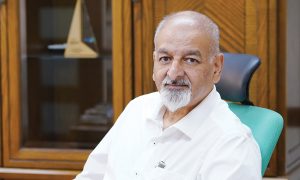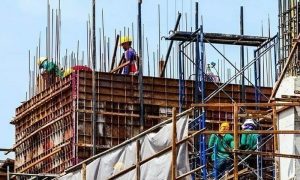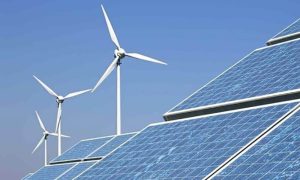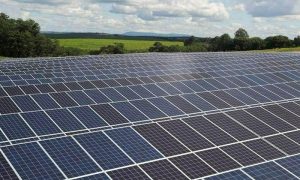By: Dr Azhar Iqbal Jaffri,
cheif executive ofiicer at Potantia Engineering Solutions.
The atmosphere is useful to humans for more than just these natural processes. People exploit the atmosphere’s vastness by using it as a repository for the gaseous waste products of industrial society. And now the quantity of air pollution is overtaking us. Cities, rural areas, and even national parks are plagued by polluted air. Its impacts on human health could be the most drastic since human lungs, containing very sensitive tissues, receive daily around 15Kg of air compared to 2.5Kg of water and 1.5Kg of food. Moreover, polluted air spreads over long distances and can practically not be avoided. Also, the global impact of pollution-related phenomena such as global warming has been proven to have alarming consequences. This has led governments and local authorities, mainly in industrialized countries, into taking these issues more seriously and hence establishing various emissions limits and standards and implementing mitigation measures to reduce the pollution of the air down to bearable levels.
Clean air is the foremost requirement to sustain healthy lives of humankind and those of the supporting ecosystems which in return affect the human wellbeing. Release of various gaseous emissions and particulate matter (PM) has been on the rise due to rampant industrialized growth Anthropogenic emissions of various kinds are being pumped into the atmosphere (called primary pollutants) and lead to the formation of new pollutants due to chemical reactions in the atmosphere (called secondary pollutants). These are building up the concern of ambient air pollution (AAP) as a prominent global threat to human health in many ways. For instance, according to the Fifth Assessment Report of the IPCC ‘nearly all the non-CO2 climate-altering pollutants are health damaging, either directly or by contributing to secondary pollutants in the atmosphere’.
It is essential that the hazardous impacts from environmental pollution are regularly reported and monitored. Of the various kinds of pollution, the air pollution has attracted high priority in respect of environmental regulation since the environmental damage due to such pollution mostly affects human well-being directly by way of adverse health effects on the population exposed to it. Air quality has deteriorated in most large cities in Pakistan, a situation driven by population growth, industrialization and increased vehicle use.
The main change in the atmospheric composition is primarily due to the combustion of fossil fuels, used for the generation of energy and transportation. Variant air pollutants have been reported, differing in their chemical composition, reaction properties, emission, persistence in the environment, ability to be transported in long or short distances and their eventual impacts on human and/or animal health. However, they share some similarities and they can be grouped to four categories:
- Gaseous pollutants (e.g. SO2, NOx, CO, ozone, Volatile Organic Compounds).
- Persistent organic pollutants (e.g. dioxins).
- Heavy metals (e.g. lead, mercury).
- Particulate Matter.
Although pollutants include constituents that are naturally part of the atmosphere, such as CO2, human activities may release them in higher than normal quantities. Some compounds are pollutants because they are present in a region of the atmosphere where they do not belong; for example, the ozone that acts as a shield against UV rays in the stratosphere is a pollutant when it is in the troposphere. Other pollutants may cause important compounds that are naturally present to become less abundant, as with the destruction of stratospheric ozone by man-made chemicals. A few pollutants combine with water vapor to become acids. Excess heat also can be considered a pollutant, and urban areas suffer from increased temperatures and more variable weather as a result. As per the world average 49% of the air pollution is produced by transportation, 28% from fuel burned in factories and power planets, 13% from evaporation of volatiles, 3% from solid waste disposal, and 7% from miscellaneous other sources. The major pollutants include ozone, particulates, Sulphur dioxide, nitrogen dioxide, carbon monoxide, and the heavy metal lead. Air pollution today is largely caused by the burning of fossil fuels. Primary pollutants enter the atmosphere directly, from a smokestack or tailpipe. Secondary pollutants form from a chemical reaction between a primary pollutant and some other component of air, such as water vapor or another pollutant. Ozone is the major secondary pollutant.
Indoor air pollution is often more harmful than outdoor air pollution, especially because we spend the largest portion of the day indoor, inside our home or office. The air inside our homes and offices can sometimes be much more polluted compared to outdoor air, and thus present a major health threat. In order to reduce heating or cooling costs (depending on which region they live) many people try to make their homes and offices more airtight which often leads in inadequate circulation of the air and high levels of indoor air pollution that could have adverse effects on human health. Indoor air pollution is particularly hazardous to elderly people and young children, and can not only lead to respiratory diseases like asthma but also cause heart problems. Indoor air pollution is yet to be widely recognized issue and there has been very little scientific data about emission rates from different appliances we use in our home and offices. There also hasn’t been adequate regulation on indoor pollutants that would regulate the acceptable level of indoor air emissions. There needs to be far more research about the indoor air quality because the effects of indoor air pollution on our health mustn’t be overlooked.
You may experience any of the following problems.
- Chest discomfort like trouble taking a deep breath or feeling like you are having a heart attack
- Shortness of breath
- Phlegm/mucus production
- A cough where you may or may not bring up mucus
- Wheezing which may worsen with activity
- Decreased lung function on breathing tests, electrocardiogram (ECG) changes, including irregular heart beat (arrhythmias) or changes showing your heart is being damaged (ischemia).
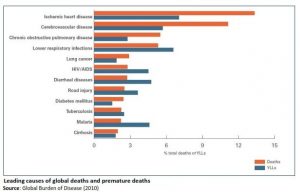
The first step to controlling air pollution problems is to identify their source. Long-term monitoring of major and minor pollutants is to be set up in all regions. Once problems are identified, pollutant emissions are reduced through the use of cleaner fuels and the installation of pollution-reducing technologies. Due to the development of new technologies, the next decade or two should see reductions in emissions from power plants, industries, and motor vehicles, at least in the developed nations.
It is crucial that political leaders worldwide and the leaders of industries that cause air pollutant emissions take actions to reduce these emissions. The preferred approach for reducing air pollution is to keep the pollutants from entering the atmosphere. One way to do this is to reduce reliance on the energy sources that produce the most pollutants-fossil fuels-while phasing in alternative energy sources, such as hydropower, wind energy, geothermal energy, nuclear power, and solar energy (although a few of these have other environmental or health impacts that bear serious consideration). A change of this magnitude is difficult to accomplish. For one thing, large scale use of these energy sources would require large technological developments. For another, a change like this would require a transformation in the energy infrastructure. == People would likely get energy from different sources depending on their location. Some regions can take advantage of its seemingly nonstop sunshine, for conversion to solar energy. Some regions can rely on windmills. A strategy like this would make energy production less centralized, thereby reducing air pollution to a significant level.
Another possibility for reducing emissions is burning cleaner fuels. Power plants, for example, could be restricted to burning natural gas and low-Sulphur coal. Motor vehicles could burn natural gas exclusively.
There are several ways to remove pollutants from power plant emissions. Scrubbers eliminate particulates, SO2, hydrogen sulfide, and other pollutants from waste gases as they pass through a solution before leaving the smokestack of coal-firing and other plants. Baghouses, enclosed structures that run emissions through filter bags in the same way as a vacuum cleaner, collect more than 98% of dry particulates. Cyclones collect toxic gases and particulates by using centrifugal forces, which are motions that proceed outward from a center. Electronic precipitators use static electricity to collect and remove unwanted substances that are suspended in very hot gases. Technologies are being developed that will reduce power-plant emissions even more. One exciting new technology is that of gasification, which has been tested but has not yet been used in a full-scale power plant. Gasification produces clean coal, which is more efficient and produces far fewer emissions than normal coal.
Cars and other motor vehicles emit far less pollution than they did just a few decades ago. This is due to the higher emissions standards, improvements in fuel quality, and the installation of pollution-reducing technologies in many vehicles. One emission- reduction technology found in all modern cars in the United States is the catalytic converter, which is used to reduce and oxidize three pollutants: CO, NOx, and VOCs. An emerging option for reducing pollution from motor vehicles is hybrid vehicles. Hybrids use old technologies a small internal combustion engine, an electric motor, and a rechargeable battery and combine them in new ways to use fuel more efficiently. A normal car burns gasoline in its internal combustion engine for energy. When the brakes are applied, the vehicle’s kinetic energy, the energy it holds because it is in motion, is lost. This wastes fuel and produces harmful tailpipe emissions. Hybrids also burn gasoline to run the combustion engine, but during braking they harvest the vehicle’s kinetic energy to regenerate the battery, saving fuel and emissions. Since hybrid engines are small, the car is lighter and takes less fuel to operate. When conditions are right for the car to run only on the electric motor and battery, such as at constant speeds around town, the gasoline engine shuts off completely.
Fuel cell technology may someday be used in motor vehicles, but it is far from ready for that purpose right now. Like batteries, fuel cells convert chemical energy into electrical energy, but fuel cells do it very efficiently. Most of them harness the energy that is released when hydrogen and oxygen are converted into water. The by-products of this reaction are water vapor and heat. Unlike batteries, which are sealed so they contain all their chemicals, fuel cells have chemicals constantly flowing into them, so they never go dead. In addition, vehicles run with hydrogen fuel cells have no emissions no pollution at all. Fuel-cell use is in its infancy, but it is entering a rapid growth phase. Fuel cells are replacing batteries in portable electronic devices, where they are advantageous since they last longer and are rechargeable.
The Earth and its atmosphere face many difficult problems brought about by human activities. Some of these troubles have already been dealt with in positive ways. Phasing out ozone-depleting chemicals has reversed the increase in the size of the ozone hole and may lead to its near repair within several decades. Pollution- control devices have cleansed the air of some harmful pollutants. Concentrations of the six major pollutants ozone, particulates, Sulphur dioxide, nitrogen dioxide, carbon monoxide, and lead have declined in much of the developed world, and the air over many cities is much cleaner than it was a few decades ago. Pollution-control devices also diminish the pollutants that bring about acid rain.
Many people still breathe dirty air, and many lakes and streams suffer from high acidity. As Earth’s population grows, and there are more cars and industries, more drastic solutions will be needed so that air quality can continue to improve. Economic incentives to reduce energy use and to advance and expand the use of pollutant-reducing technologies must be increased. Incentives can target industry, small businesses, and even individuals, who can be motivated economically to purchase less polluting cars or to use public transportation. Where incentives are not enough, pollutant emission restrictions will need to be discussed and implemented.
Most activities necessary to reduce pollution levels require long term actions and commitments. Before large changes in society can be made, people will need to make changes in their attitudes. Everyone should gain knowledge of the science behind the problems facing us and make informed decisions regarding lifestyle choices. Individuals need to do what they can by reducing the amount of driving they do. With education in the needs of the world and its environment, coupled with hope and enthusiasm, young people will play a major role in implementing change. The path the world is on can be turned, incrementally and completely, with knowledge, dedication, and determination.





